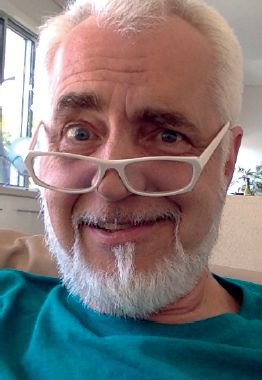
Interview by Peter Ward
Please introduce yourself in a few words.
Ahoy hoy! RJ Mical here. I first fell in love with computers and computer games as a child when I played with an oscilloscope version of Pong I saw at a science museum. As a young teen I met the Intellivision game system and missed dinner that night because I couldn’t tear myself away, and when I got home I found a sheet of graph paper and designed my first video game characters. I knew from the beginning that my love was computer entertainment, but I didn’t realize that it would become my career too.
What did you want to do for a career when you were at school, and what was your first job?
I started out aiming for an English degree at the university, but I switched to Computer Science and ended up getting degrees in both, with a minor degree in Philosophy. What a ride! My first job was peeling potatoes in the basement of a restaurant, before I was legally old enough to work. The first company I created was an above-ground pool building operation. My first computer job was at Sciaky Brothers on the south side of Chicago, where I started to learn what it means to be a professional, and where I especially learned that a job can be fun if you make it so. I miss my Sciaky brothers very much.
What was your first experience with a computer?
I played an early version of Pong when I was a kid, and I started playing computer games on the Intellivision when I was a teenager. I designed and built my own tic-tac-toe computer soon after that. The first computer system I bossed around was an IBM 360, the Big Blue, which I programmed using punch cards! The first flight simulator I played was Airfight on the Plato system, and it turned out that that program was the first-ever multiplayer flight sim — the first ever! The first home computer I programmed was the Apple IIe, owned by my beloved mentors Dolores and Fred Maurice — this was also the first computer I stayed up all night programming (but not the last), and the first computer I fell asleep in front of (but not the last). The first hardware I helped design was at Williams Electronics, where we tweaked the fancy DMA needed to create the Sinistar imagery, and we put together the entire hardware plan for the Star Rider laserdisc game. The first whole computer I helped create with my own hands was the Amiga, which is still my favorite computer to this day, both to use and to program (although I am quite fond of PS3 SPU SIMD programming, I must say).
When did you realize you wanted to get into the game industry, and how did it happen?
Great question! I guess I always knew I would create games and computer entertainment, but the actual choice to join the game industry didn’t happen until I was in my mid-20s. I had a computer science job after college that was fun and challenging, but it wasn’t really me. Right after that job I took a year off and traveled around the world — literally around the world — and at the end of that trip I was a changed person. I knew I had to do something meaningful with my life and my skills; I love to program, but also to make music, to paint and draw, to tell jokes and stories. And more. What job could I find that took advantage of these varied skills and interests? Video games, of course. The premier arcade game company of that era was Williams Electronics, so I begged my way into a job there, and the rest is history. Honorable shout-outs go to two lifelong friends: guru Ken Flisak, who helped me see that computer entertainment was the way to go, and game lord Noah Falstein, who took a big chance on me and gave me my job at Williams, which proved to be my break into the industry.
From 1983 to 1984, you worked on several games at the arcade games developer Williams Electronics, as a software engineer and a special effects artist. What was your favorite and least favorite parts of Williams?
Mmm, I might say my favorite aspect of Williams was the people, because I met so many brilliant engineers, designers, and artists there — even the business people were good! Or I might say the best thing was that I had found a calling, a home, in the game industry. But, in fact, my favorite part of Williams was the arcade room we had downstairs, where we had a copy of the most popular arcade games of the time, all set on Free Play, and I was encouraged to spend at least an hour a day down there playing the very best arcade games, for free. It was my job! Meanwhile, I can’t remember disliking anything about working for Williams. We didn’t go on enough ski trips? There was a woman there whom I loved but I couldn’t get her to notice me? I once wore a pair of blousy blue muslin pants to a design meeting with grizzled ol’ hardware guys, and that didn’t work out too well for me, but, really, the job was just excellent in every way.
Was Sinistar the first videogame you ever worked on? Please describe the experience.
Sinistar was my first video game. They hired me on as a special effects creator, but I ended up contributing to the multitasking enemy intelligence and the security system too, plus I helped with some last-minute changes to the hardware DMA. I also goofed around with the audio engineer while he was creating the voice of the game, and I believe that some of the voice samples in the final game are my voice. Alas, there is no way to know anymore as all of that work ended up in a dumpster when Williams shut down their arcade game division. What a shame! If I had known they were closing, I would have gone dumpster-diving for souvenirs.
You coordinated the Star Rider project, Williams’s first and only Laserdisc game. Please tell us what this involved.
Oh, we had so much fun! We were inventing all sorts of next-generation tech, including this fascinating NTSC codec for horizontally squishing a rendering of the 3D world onto a laserdisc, which allowed a video playback experience that could be panned left or right. We invented a dynamic object rendering and collision system that adapted to the video. And I got to work on a sit-down game! And, finally, the success of the Star Rider technology helped get me the offer to join the Amiga startup where — BAM! — my engineering life advanced to the next level.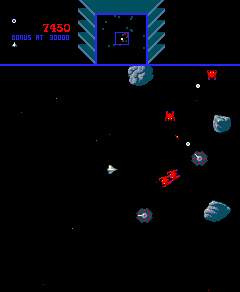
From 1984 to 1987, you worked for Commodore as software engineer. You created development tools, and animation system software, then went on to invent Intuition, the Amiga user interface system software, which was a high-renowned full-featured windowing and menu interface for the Amiga. How long did you work on the Intuition, and what hurdles did you have along the way?
In the beginning, the Amiga had no UI (user interface); you had to type commands into a terminal window to communicate with the system. When Commodore bought us, we had to switch our target from game system to a full computer product. To complete that transition we needed a UI, and we wanted to launch ASAP so we needed a UI in a big hurry. Intuition took seven months to develop, a grueling seven months, during which I worked 100 hours per week, every week, to get that baby done in time for the launch. The calendar was the biggest constraint; I wanted to do it all, but I had limited time to get it done. Fortunately for me, all of the real heavy lifting had already been done by my fellow Amiga engineers who had created a superb foundation of hardware and system code that made it much easier to build up something as complex as Intuition.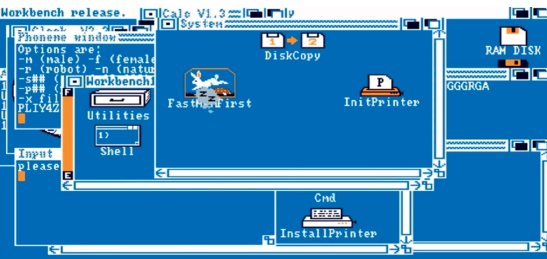
Are there ideas that you would have liked to have integrated into Intuition, but which could not be made, for lack of means and time?
I felt that Intuition was 1.0 complete. I got in every feature I set out to create, including one for which I got a patent. But there was one major flaw: The system was designed to run in the calling program’s execution space, rather than as a standalone OS task, a “device driver”, and this caused performance degradation until future software engineers corrected the problem.
How far along was the Amiga project when you joined?
The Amiga was in the malleable design stage when I joined. The hardware was still being laid out — using pencils and paper! — and the OS components were still mostly abstract sketches in the minds of the inventors. We had a whiteboard with a block diagram of the hardware pieces, and the software people could explain their plans and how the pieces would interconnect, but nothing was cast in stone, and every engineer was nimble, flexible, and wholeheartedly collaborative.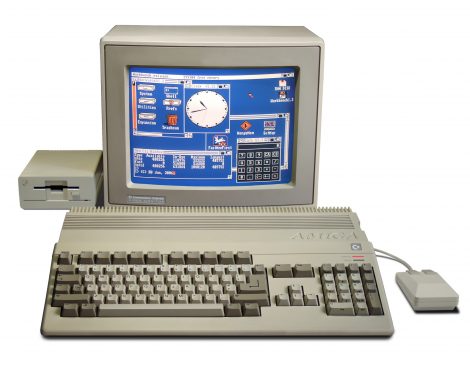
Did the Amiga success surprise you? Why do you think it did so well?
After the machine existed, the success didn’t surprise me, no. Clearly we had created a champion. What surprised me most was that we had managed to create a champion after all. Unbelievable. We were a humble bunch on a mission, and we succeeded! When I joined the team I had hope that we might create something great, but I didn’t dare dream that the final product would end up with that much potential, and would enjoy so much support from the community.
Do you think that if you had worked on the Atari ST, you could have given an equivalent to Intuition?
Alas, I don’t know enough about the ST to know if it could have supported Intuition, but I don’t think so. The Amiga was an astounding hardware platform, and the Amiga OS had a sophisticated multitasking core, with many layers of system software built up on top of that. Intuition depended heavily on that underlying strata of hardware and software. The only reason I could reach for something as sophisticated as Intuition is because I was standing on the shoulders of giants, you see. Atari had some fantastic engineers working for them, but the ST was rushed to market and lacked the power and features of the Amiga, such as multitasking, so it would have been very difficult if not impossible to create something like Intuition on the ST.
You were involved with Defender of the Crown. Please explain what you did during the creation of this game?
I don’t talk about my experience with the development of that game, except to say that Kellyn Beck the game designer and Jim Sachs the artist were geniuses. Alas, the publishing company cheated me and I was too inexperienced at the time to do anything about it. I took my name out of the in-game credits, but I couldn’t stop them from putting my name on the box, so people know I worked on it, but the story stops there. For more details, you’ll have to ask the scoundrels who ran the company at the time.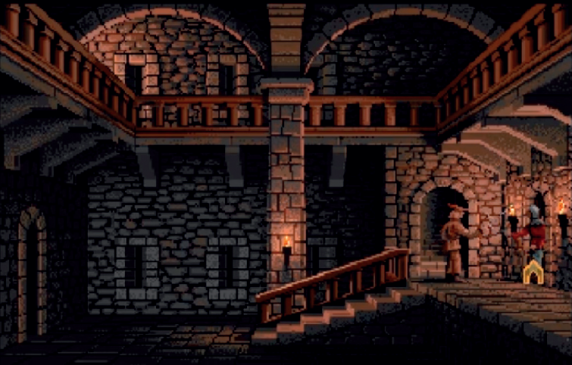
In 1987, you left Commodore. What were your reasons for leaving?
I left Commodore because my fearless leader Dave Morse convinced me that I could do more good for the Amiga outside of the company, helping Commodore as a contractor and also helping developers create new apps and hardware devices for our baby. And he was right!
From 1987 to 1989, you were the co-inventor at Epyx of the first color hand-held game system, the Lynx, which finally was acquired by Atari. You were the co-designer of the Lynx hardware system and the run-time libraries. How did Atari acquire Epyx?
Atari named the product Lynx. Our internal codename for it was Handy. While we were finishing the development of the Handy, Epyx at the same time was busy sinking their meager financial resources into developing video tape games, where you would play a board game, then stop to watch some of the tape, then play more game, then watch more tape. It was lame. They sank so many millions into it that there was no money left to produce and market the Handy. So Epyx went looking for a buyer. The scoundrels at Sega looked at the device, walked away with schematics, and then passed on our device to create their own Game Gear which turned out to be nearly identical to the Lynx (no surprise there). So instead the smarties at Epyx sold the product to the scoundrels at Atari, who then drove Epyx out of business, as we predicted.
What parts of the Lynx were you involved with? Please, go into detail.
Dave Needle and I “co-developed” the Handy. We referred to ourselves as co-developers because we both did all of it together. Dave did the hardware, but also was intimately involved in my development of the runtime libraries and development tools. I did the software, but also was intimately involved in the features and industrial design of the hardware. And we both helped with the games. This was the beautiful basic truth of every project we worked on together: It was always a joint effort. Gosh, I loved working with Dave Needle. I miss him so. Long live Dave Needle.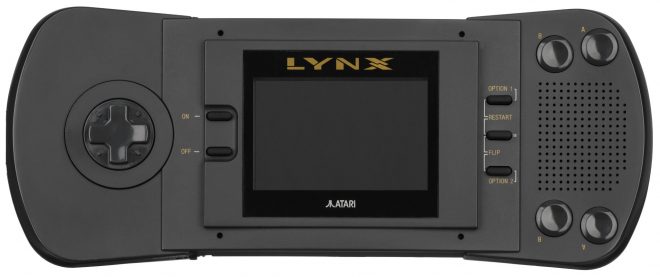
By developing the Lynx, what was your goal?
We wanted to have lots of fun, revolutionize the game industry, and make lots of money. Dave Morse met with Needle and me in a restaurant one day and said that his son had suggested an idea about a handheld game system, which Morse liked, and Needle and I liked too. We did some drawings on a restaurant napkin, and we were off to the races … because it sounded like a fun thing to do!
The Lynx had impressive scaling capabilities. Why did you include that functionality?
We included scaling because we wanted it. It’s that simple. We wanted it because we knew game developers would use it. A lot of what we put into the Lynx came from this sort of shoot-from-the-hip mentality. We didn’t do a lot of user studies, we just created what we knew was needed. In the case of scaling it was easy an easy choice to make, because we knew that game developers wanted image rotation (huge memory savings), and scaling was just a few extra logic gates added onto the rotation circuits.
What is your opinion regarding the Game Gear and the Game Boy?
The Game Boy was a brilliant game system. Inexpensive, small and lightweight, changeable games — it was everything consumers wanted. Regarding the Game Gear, well, Sega ripped us off. When we were trying to sell the Handy we ultimately showed everything to Sega, including software documentation and a full set of the technical drawings. Then suddenly they informed us that they didn’t want to make a deal with us, and soon after Sega announced their own Game Gear, which matched the Handy in countless ways, down to the same display drivers and exact screw count, for example. It was shameful. And then our Handy was given to Atari! Sigh. The whole end-story of the Handy was about heartbreaking loss.
What was the budget for the Lynx development?
I don’t remember the details. We said, “Give us 25 people and a lab, we’ll take care of the rest.” I do know that we always stayed within budget, which was one of our lifelong claims to fame: “On time and on budget.”
What was the deal between Epyx and Atari about the Lynx?
I know little about the business details for the sale of our baby to Atari. When Epyx informed us that they were thinking of selling our Handy to Atari, Needle and I told them that we would quit if they did. Some of the people who ran Atari at the time had a history of treating people unfairly, and we didn’t want to have anything to do with them. We knew that selling the Handy to them would mean the doom of the Handy, and, we warned our board, it would ultimately mean the doom of Epyx. We were right. Epyx finally went bankrupt because Atari wouldn’t cooperate, and the Atari Lynx failed because the price was too high (because the hardware suppliers had been burned by them in the past, so now they demanded top dollar for supplies and manufacture), and software developers would not develop games for the Lynx (because they had been burned by them in the past, so now they simply refused to get involved). And so the Lynx died.
In addition to co-designing the Lynx, six games were to be available at the launch of the system. You produced these six titles, and you were co-designer of several of them. What was your favorite title you worked on and least favorite and why?
I didn’t have a least favorite game — I loved them all. My most favorite of the original six, looking back across the fullness of time, is probably Blue Lightning by Stephen Landrum. Landrum was an engineering genius and a game development god. Right behind Blue Lightning was California Games, which included the BMX challenge with its delightful rating system of Pretty Good, Not Bad, and the highest rating: “As Good As James” — ah, I hope I can find James Donald again someday. But my favorite Lynx game of all time was Warbirds. Many of my friends and I developed “Lynx Thumb” from playing too much Warbirds against each other.
Ironically, Atari bought Epyx, and then you worked for Atari, after what Atari did to Amiga. Having to support this firm must have put a lot of pressure on you, so how did it go?
Well, no, we never worked for Atari. Needle and I quit before Epyx sold the Handy to Atari, as we swore we would do. Instead we got to enjoy, from afar, the irony of Atari buying Amiga hardware systems so that they could do Lynx development. (Once upon a time Needle and I went to the Epyx death auction and bid up the prices of the Amiga development kits when Atari was trying to buy them — it was great fun!) The Atari engineers were a sharp bunch and it would have been good to work with them. But the Atari management, not so good. They could fool the fools of Epyx into giving them our device, but we were determined that they would never have us.
What are you wearing today?
Me? I’m wearing reading glasses. I didn’t need them before. Do you think they make me look cool?
In 1990, you co-founded NTG (New Technologies Group), a company formed to design a new game system which was destined to become the 3DO. What made you decide to form this company and leave Epyx acquired by Atari?
We would have nothing to do with Atari. We quit Epyx instead. The very next day after we left Epyx, Needle and I met to start planning our next system, the 3DO, codenamed Opera (because it was going to have a built-in CD drive and we wanted to conceal the importance of that).
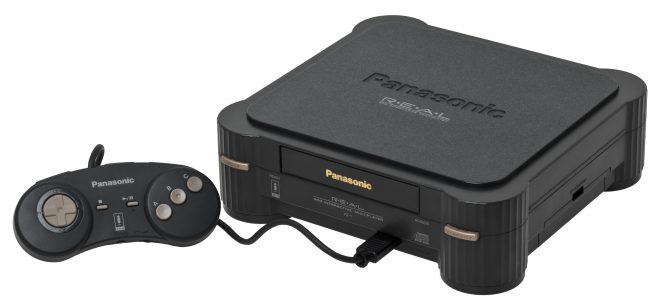
How was your partnership at NTG? Was there a good team at NTG and did you work well together? Are you in touch with any of the team still?
The partnership of Morse, Needle, and Mical was a powerful triumvirate. Morse did the business, Needle did the hardware, I did the software. It was a superb arrangement. We had no problem recruiting engineers from across the Valley to come join our latest undertaking. And yes, I’m in touch with most of the NTG team to this day. They come to my parties! You should come to my parties too.
How was working with Trip Hawkins on the 3DO? Did he have any special requests or did he follow your ideas?
Heh. Trip was fun to work with! But Trip (and his lieutenants) didn’t follow many of our ideas. Trip had his own vision, as you might imagine. He used the hardware and OS we developed, but he chose to replace our tools and game development teams with personnel of his own. We even used the Amiga as the original development platform for the Opera, but Trip threw all that away and switched to using a Mac, which proved to be a mistake. Using a PC would have been better than the Mac! But sticking with the Amiga would have been best, in my humble opinion. And meanwhile, Needle and I were driven mad by Trip’s retail price-tag of the system, which finally led to the 3DO’s demise.
What exactly was your involvement in the development of 3DO?
As with the Amiga and Handy projects, Needle and I played to our Dynamic Duo superpower: We designed all of it all at the same time: the hardware, operating system, tools and games. We picked the NTG office building specifically because it had two offices with an internal door connecting them, so we could meet or simply shout questions to each other through our internal door even when the external doors were closed for privacy or whatever.
Did your experience on the Amiga and the Lynx help you for the 3DO?
Interestingly, many of us think of the 3DO OS as “the Amiga OS done right”. Several of the original Amiga people, such as Dale Luck, joined up again to develop the 3DO hardware and OS. We were wiser and more experienced at that point, and we relished the chance to “do it again” while avoiding the rookie mistakes we had made on the Amiga. And we were successful! It wasn’t perfect, but the end product was much better than our earlier systems.
In your opinion, what did the Lynx lack to be successful?
When we created the Handy (which became the Lynx) we had arranged delicate friendship-based agreements with hardware vendors and software development companies that would have resulted in a low-cost game system with a rich library of games. After the project was sold, the new owners had a long history of ripping off hardware providers and software developers, so, understandably, the cost of the hardware went through the roof, and many of the best software developers decided to put their resources elsewhere. So the launch unit was too expensive and had very little software, and it never recovered from that abysmal start. The Lynx was a beautiful bit of engineering that should have seen the light of success! But the system was doomed to wither and die in the shadows of retribution.
In your opinion, what did the 3DO lack to be successful?
It was the launch price tag that killed any chance of 3DO success. The lack of software titles at launch didn’t help either — but my team got one done! and to this day I am proud of them for that.
In 1996, you founded a new company, Glassworks, with a particular aim at creating online multiplayer games. What notable projects were you involved in?
We never finished the technology we were developing at Glassworks: Think Minecraft with lots of prebuilt user-extensible objects, and twelve years earlier. Imagine the potential! It could have been a huge success! Alas, it never saw the light of day. This was particularly heartbreaking for me as we had assembled a team of some of the finest designer/engineers I’ve ever known, only to have the whole thing flushed down the toilet, squandering that amazing opportunity. Sigh. We could have ruled the world! What a waste.
Between 1998 and 1999, you started writing fiction books. Your first book was called “Building a House.” What made you decide to have a break from technology and write a book?
I had to deal with the demise of Glassworks, and when that was over I decided I had had enough of the software industry for awhile. So I took the time to pursue one of my other dreams: I moved to Amsterdam and wrote a book. That first book was, you know, OK. The second book I’m writing now is much better.
Between 2003 and 2004 you became GlobalVR Vice President which took software from popular PC and console games and created an arcade version of the game. Which notable games were converted?
More than any other client, we worked most closely with Electronic Arts to create internet-connected arcade versions of their hit titles Golf and Madden Football. We found out later that serious gamers were using Golf for contests where hundreds of dollars were being gambled per game! It was a huge success. I’m delighted to report that that stubborn little company still exists today.
Between 2005 and 2011, you were employed by Sony Computer Entertainment, to develop software, architecture, and tools. As senior manager of SCEA’s centralized core technology team, you led development of low-level runtime system technology for the PS3, the PSP, and the new PS Vita. Please go into detail, what this involved?
I joined Sony originally to learn about the “organic” PS3 architecture, which fascinated me. I only expected to stay at Sony for about a year, but in that first year we built a superb team of engineers, and I didn’t want to let it go, so in the end I stayed at Sony for six whole years. During that time I worked with many top-shelf engineers, but I also had to work with a lot of arrogant jerks, and my favorite managers there exited the company before me, so finally I had no regrets leaving that experience in my rear-view mirror. Sony was my first “big corporation” experience, and I swore that it would be my last, but then along came an opportunity at Google where I work now, surrounded by joyful geniuses, and I couldn’t be happier.
What in your opinion are the differences between the Japanese game market and the Western one?
Tough question! I don’t know how to quantify the difference between the Japanese and American game markets. Japan prefers more fantasy, American more graphic realism? There is a big difference between the European and American gamers too, and even in Europe you can see the subdivided differences between the various territories. Even in America I feel that the northern players are OK with some storytelling, while the southern players mostly want to get right to the action. But for a better answer, you ought to ask the experts — I ain’t no expert.
Which are your best and worst memories in the industry? What is your biggest regret of this time?
My fondest memories are all connected to the excellent people I’ve met through the industry, and my best times came from seeing our projects make it into the marketplace. Sadly, I’ve taken a beating a number times in the industry and that has hurt like hell, but my worst memory came from watching Dave Needle tumble downhill emotionally after the collapse of 3DO. He had (yet another) fortune at his fingertips that evaporated before his eyes, and the experience crippled him. He never recovered, really, and it was devastating to watch that tender soul get crushed by the reality of 3DO’s downfall.
How do you view today’s consoles?
Every few years consumers are asked to discard their existing hardware and their entire library of game software, and then pay big bucks to get a new system and new software with, at most, a few minor improvements in sparkle. I don’t get it. The games aren’t any better; in some cases they’re worse, as developers invest more in sparkle and less in gameplay and debugging. I don’t understand why consumers put up with it. I don’t anymore; I haven’t bought a new game console in years.
I enjoy many modern games, but feel the same for the smaller teams of the past. I feel some fun factor has gone in modern games and are more like movie productions; games can be bug-ridden now as patches can be made. In the past we didn’t have updates and in-app purchases. What is your view of our modern industry?
I’m not entirely fond of the rising emphasis on cinematic moments in games. I don’t like the fact that games in general are becoming more dependent on passive storytelling, where developers are packing in movies that I don’t watch anyway. I like a simple, compelling game, where the story is revealed by the action, not by some embedded TV show.
Do you have an encouraging word for your fans?
Oh yeah! Believe in yourself. Don’t be afraid of change. And never bunt; always try to hit the ball out of the park; always aim to join the company of the immortals. If an everyday kid like me from the south side of Chicago can do it, you can do it too.

